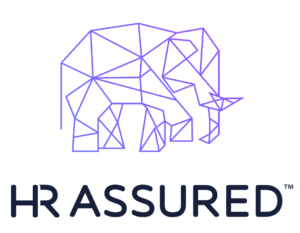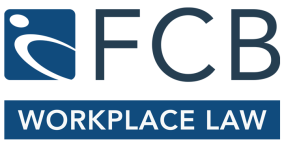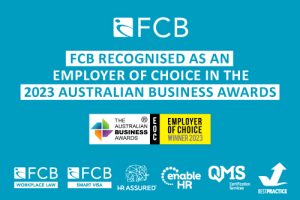Staying Ahead of the Curve: Overcoming Workforce Management Challenges in the Aged Care Industry
May 16, 2019Jessica Fisher, Partner at FCB Workplace Law, explores how aged care providers can gain a competitive advantage in both employment and commercial spheres by embracing workplace flexibility, being proactive and responsive to change, and getting the balance right between compliance and productivity.
“2019 looks set to be a year of challenges and change. The Aged Care Royal Commission and Federal Election (with possible new government), mean that change-fatigued providers need to focus on the risks they can influence in order to succeed in an ever-changing landscape.”
Being compliant while managing your workforce in today’s aged care industry is fundamental to mitigating risk and achieving greater success. Changes to our workplace relations system, and the vagaries and challenges of dealing with diverse and individual staff, can make this seem like an uphill battle. But there are ways to do it better and stay ahead of the curve.
Which Government? What Laws? Who’s the Leader? What?
If the last decade has taught us anything, it’s that Australian politics are unstable, unpredictable and occasionally embarrassing. With a Federal election looming in 2019, and the increasing likelihood of a new government, prudent providers are already monitoring the agendas of each party to see in which direction the winds of change might blow.
The Labor Government has been vocal in its disapproval of more business-supportive changes, such as the reduction of penalty rates, even pledging to reverse the decision, while the Liberals support benefits to businesses and continue their hardline approach towards union accountability and transparency. The Greens aim for the best of both worlds: pledging support for the rights of both workers and small businesses, although seeming to favour the Left by endorsing the #ChangeTheRules campaign and promoting increased access to industrial action and restrictions on casualisation.
With uncertainty as to which party (or leader) will emerge victorious from the 2019 election, the best thing providers can do is to keep up to date with regulatory changes, develop effective workplace management strategies that strengthen ties and relationships with staff, and adopt flexible workplace structures that can adapt to amendments such as the new casual conversion regime.
In view of the political uncertainty and resultant industrial framework uncertainty, we recommend locking in workable arrangements within the current system to afford your business maximum security, stability and flexibility. While it’s unclear which specific reforms a Labor Government would push to get into legislation, based on their current public platform they’re almost certain to include greater restrictions and limitations on the ability to deploy your workforce to your maximum advantage.
The Royal Commission into Aged Care Quality and Safety – 2018/2019
The announcement, in late 2018 by Prime Minister Scott Morrison, of a Royal Commission into the aged care industry, with terms of reference focusing on the extent of ‘substandard care’ and the challenges facing providers in delivering care to an ageing and diverse population, caused widespread consternation and alarm. While the intent of the Royal Commission may be commendable – to achieve a stronger and safer system of care for our vulnerable older population – an already-demanding regulatory regime only makes the burden on providers heavier in respect of the additional documentation and evidence they will be called upon to provide as part of the Commission’s review: and the inevitable reforms that will come out of that review.
The Royal Commission’s “invitations” for self-disclosure, sent out to every operating aged care facility, are tantamount to a requirement to produce any and all potentially damaging material, and will certainly be used to direct further, and possibly public, inquiry.
While preparing this information and reviewing past and current practices may be daunting, providers should not delay their preparation, including the analysis of their workforce. In the event that the Royal Commission does critically, and publicly, scrutinise your business and its practices, if you’ve already taken steps to rectify prior issues, and undertaken remedial action by the time of the hearing to ensure these issues won’t happen again, then the Royal Commission and public are sure to be (somewhat) less damning. In addition, in order to comply with Standard 7 (Human Resources) of the Aged Care Quality Standards, it’s essential that providers conduct a full audit of workplace arrangements, including a pay audit, assessment of industrial instrument compliance, consideration of training requirements and qualifications, a review of policies, and use of a nimble Human Resources Information Sysytem (HRIS) platform (such as www.enableHR.com) to effectively manage and deploy their workforce. An effective and well-deployed IT platform can manage a multitude of risks, including supporting effective management by your front-line facility managers, consistently rolling out HR policies and procedures, increasing effective communication across all (including remote) facilities, and managing bullying, discrimination and harassment risks and occurrences, maximising staff retention and acting as a cornerstone of your workforce management strategies. An effective HRIS can also be used as evidence of your ability to defend, or at least manage, anything that might fall into a “systemic failure” category.
Increased media and public scrutiny have also raised the stakes in respect of each provider’s actual, and perceived, compliance. Providers will need to be mindful of the Aged Care Royal Commission adopting the Financial Services Royal Commission’s “community standards and expectations” approach. Businesses in Queensland will have the added encumbrance of complying with the Queensland Government’s Inquiry into Aged Care, End-of-Life and Palliative Care during 2019.
Changes in 2018 and Impact on Providers
Casual Conversion Entitlements
From October 2018, new obligations in relation to casual employees commenced in the Aged Care Award 2010 and the Nurses Award 2010, allowing regular casual employees the right to request conversion to permanent employment after a period of 12 months. With a casualised workforce necessary to ensure resident care, the casual conversion decision places some onerous obligations on providers to undertake additional administration to notify their casual employees, while also placing some restrictions on the ability of providers to refuse such requests.
While casual conversion entitlements is not a new concept, their introduction into the aged care industry may reduce the ability for providers to field a flexible and on-call workforce, limiting the adaptive and reactive rostering needed to meet the business’s requirements.
Managed well, however, casual conversion may actually benefit your business. As only casual employees with 12 months’ regular employment can make the request to convert, this doesn’t impact new employees and those who prefer the higher wage rates and increased flexibility of being casual, or those who are unable to commit to regular hours of work and wish to remain casual. Recruit well, roster sensibly and follow the Modern Award requirements, and the new entitlements should have a limited negative impact.
The WorkPac v Skene Decision
Perhaps one of the most controversial decisions of 2018 was in the August decision of WorkPac Pty Ltd v Skene [2018] FCAFC 131. In short, the decision determined that a casual employee, already being paid a casual loading, was deemed to be a permanent employee for this purpose and therefore had been underpaid his annual leave entitlements under the applicable enterprise agreement.
Although this case is still under the microscope, and the Coalition Government has foreshadowed the introduction of a Regulation to the Fair Work Act early in 2019 to avoid such “double dipping” of entitlements, it’s anticipated that there may be some class-actions brought by casual employees and unions. The current law as further established by Skene creates uncertainty around the use of casuals, the flexibility they can afford, and the workforce cost base. Any providers who use long-term casual employees, and provide an expectation that the casual employees may continue in such employment, risk a similar outcome and should review their engagement model and rostering to manage risk while maintaining the necessary flexibility.
Where casual employees are not working guaranteed hours or fixed rosters, and are not engaged with the expectation of ongoing work, the risks of Skene for your own business are significantly reduced. In practice, having well-drafted casual employment contracts and confirming annually (in writing) with longer term casuals that they wish to remain as casuals should help defeat any potential claim for underpayment.
Changes to the TSS Visa Program
In early 2018, the Australian Government replaced the 457 visa with the Temporary Skill Shortage (TSS) Visa (Subclass 482), introducing a wider definition of ‘adverse information’ which must be considered for any business applying to be a sponsor of a 482 visa applicant. Designed as an integrity measure to prevent the exploitation of migrant workers, this definition captures anything relevant to the business/person’s suitability as a sponsor, not limited to an actual contravention as had been the case under the 457 visa program.
In this skill-short market, aged care providers looking to attain sponsorship status should be aware that the requirement to disclose adverse information may also include any investigations conducted, or warnings issued, by the Department of Health, or the new Independent Aged Care Quality and Safeguards Commission, even if they don’t result in formal sanctions.
Despite the costs of sponsorship, with skills shortages increasing in Australia, attracting and retaining local and overseas staff is essential for stability and growth.
How do we attract and retain?
In short, don’t limit your ideas: keep your options open so you can attract a younger workforce through modern workplace culture initiatives or benefits. Longer lunch breaks so employees can visit the gym? Flexible shift times to work around parents and carers? Job sharing, time off in lieu, or purchasable leave entitlements? Free fruit in the staffroom? Whatever you offer, ask staff what they want, and constantly review what works and what doesn’t so that you are modelling and implementing a positive culture of continuous improvement (which was one of the 14 strategic recommendations of the recent Aged Care Workforce Strategy Report).
You may consider introducing incentive or benefits programs to recognise and reward the hard work and effort put in by your staff, or other benefits that make you a more attractive employer than other providers. Think about what your business values, and what it can offer that is low-cost to you but highly beneficial to your workforce. Studies have recognised that many employees work in the aged care sector for reasons aren’t primarily monetary – so working on your culture and retaining good staff fits neatly with a well-considered risk-minimisation strategy.
While the current system of Modern Awards, Enterprise Bargaining and Individual Flexibility Arrangements isn’t delivering all the flexibility that staff and employers are looking for, it can still be used with some benefits. In addition, many of the things that attract staff aren’t necessarily relevant, or need to be dealt with, within our industrial regulatory framework.
Enterprise Bargaining
Speaking of enterprise bargaining, the Fair Work Commission’s enterprise agreement approach and processes continue to present challenges to aged care providers, both in terms of the steps required to obtain approval, and the extended time it takes to reach the approval stage. Over the last two years, the median approval time for enterprise agreements has almost doubled, and our recent experiences suggest that businesses should anticipate a 3 – 6 month timeframe between application and approval.
The June 2018 decision about the use of “loaded” rates for casual employees (higher base rates in exchange for reduced penalty rates) further tightened the application of the ‘better off overall test’, unless there are limitations on the number of hours which could be worked at penalty-incurring times. This has increased the administrative burden on employers wishing to utilise such opportunities. With the additional reticence of the Commission to approve agreements which contain almost any terms less favourable to employees, on a line-by-line basis, following the Coles decision, these impediments have unfortunately discouraged many employers from attempting to bargain, with the number of private sector enterprise agreements dropping by 46% between December 2013 and June 2018.[1]
In FCB’s 2017 aged care survey, 24% of respondents with enterprise agreements had ‘extensive’ innovation drafted into their agreements. The most common types of innovation were increased leave entitlements, specifically for parental leave and domestic violence. However, only 13% of respondents had clauses in their agreements that they believed incentivised employees to work more efficiently or productively than they otherwise might, including qualification/specialisation allowances, study leave, and performance-based pay for registered nurses.
While there is likely to be some change to our industrial system that affects enterprise bargaining, it may or may not be change that supports providers’ needs. As such, we encourage you to lock in arrangements that give you some stability and cost-base certainty that also work together with the flexibility and opportunities that are still available within our current system of enterprise bargaining and individual flexibility arrangements.
At an enterprise level, policies can communicate your expectations to employees and offer them avenues for flexibility they may not have considered, such as working from home for administrative (and some other) employees, or self-managed rostering systems. While there is always a balance between risk and productivity, this balance can be managed by maintaining open communication with your employees, seeking legal or HR advice on your obligations where appropriate, and regularly reviewing your internal policies and procedures.
Where to From Here?
With a current workforce of nearly 350,000 people, forming approximately 3% of Australia’s total workforce[2], the aged care industry is heavily reliant on people for its success and accomplishments. As well as the recent and upcoming changes I’ve outlined, the considerable challenges faced by providers include the systemic industry issues of high employee turnover, often-poor employee engagement, the difficulty in attracting talent, career progression bottlenecks and the undervaluing of the aged care industry when compared to its competitor industries in the job market. All these make workplace relations seem even more daunting. When well (and proactively) managed, however, the workplace relations system can be used to your advantage, offering benefits in both compliance and productivity.
Our five recommendations for protecting your business and its brand in the workplace management space are:
- Conduct frequent (at least annual) reviews and internal audits of your systems, documentation and payroll
- Take advantage of technology by using a dedicated Human Resources Information System (HRIS) to manage and monitor your documentation and employee records in compliance with regulatory requirements
- Implement sensible, comprehensive and easy-to-read policies … and ensure your employees actually read them!
- Consider how your business can improve employee engagement and retention, including by building a positive workplace culture and, where possible, adopting flexibility and other benefits into your work arrangements;
- Seek advice and support when needed – you don’t need to do it alone!
[1] Pennington, Alison: Centre for Future Work 2018
[2] Aged Care Workforce Strategy Taskforce, A Matter of Care: Australia’s Aged Care Workforce Strategy (2018).

























